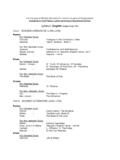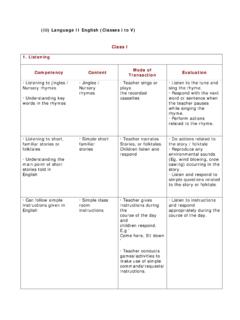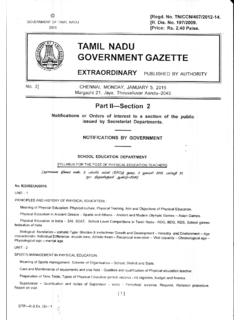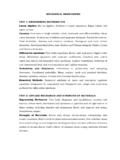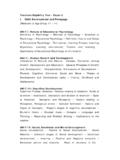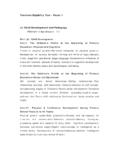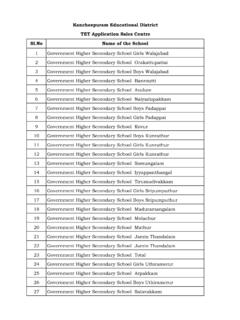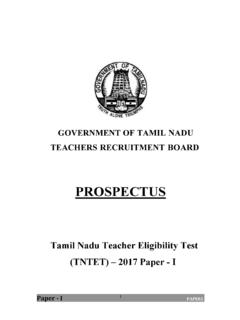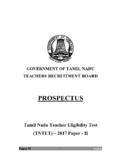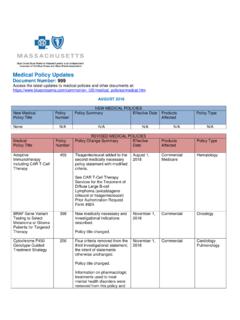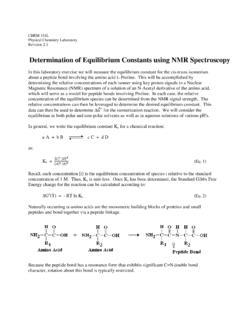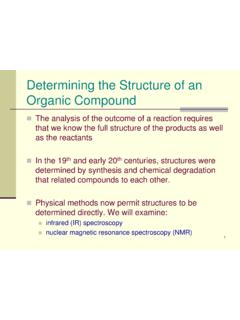Transcription of PG- 5 CHEMISTRY - Teachers Recruitment Board
1 For the post of Written Recruitment Test for the post of Postgraduate Assistants in Tamil Nadu Higher Secondary Educational Service. Syllabus: CHEMISTRY (Subject Code: P05) Unit-I Periodic properties Atomic radius ionic radius, ionization potential, electron affinity and electronegativity Their significance in chemical bonding. VB theory, MO theory applications Comparision of VB and MO theories VSEPR theory Bond order Bond energy Bond length Bond polarity Partial ionic character of bonds The concept of multi-centre bond Electron deficient compounds Hydrogen bond Its influences. Non aqueous solvents A general study of typical reactions in non aquieous media comparison with reactions in aqueous media. Solid state CHEMISTRY Ionic bonding Lattice energy Born equation Born Haber cycle Radius ratio rule Born Meyer equation Kapustinski s Modification energetics of the dissolution of ionic compounds in polar solvents different types of electostatic interactions.
2 Structural aspects of solids Fourier synthesis and analysis structure factors scattering factors Spinels and Inverse spinels defects in stoinchiometric and Non stoichiometric crystals. Electrical properties of solids Band theory semi conductors Junction devices Super conductivity Ionic conductivity Optical properties of solids Lasers and phosphors Photovoltaic effect solar energy. Magnetic properties of solids Different types dia, para, ferro, antiferro and ferri Magnetism Magnetic hysteresis. Unit II Co-ordination CHEMISTRY Methods of preparation of complexes isomerism in complexes applications of complex formation in analytical CHEMISTRY complexes and their stability chelate effect Stability constants Their determination complexes of Metals in different oxidation states and their stability. Optical activity and concept of chirality Different kinds of opticalloy active compounds configuration Foscher, sawhorse and Newman projections Absolute configuration R and S Notations Methods with more than one chiral center Asymmetric synthesis optical purity.
3 Geometrical isomerism resulting from double bonds The system of nemenclature Geometrical isomerism of monocyclic compounds and fused ring systems Sterospecific and stereo selective reactions with examples. Confermational analysis conformation and reactivity in acylic and cyclo hexane systems conformation of decalins, cyclohexane and cyclohexanone. Unit III Organic reaction mechanisms General methods of investigating reaction mechanisms kinetic and non-kinetic methods different types of reaction intermediates. Aliphatic nucleophilic substituion SN1, SN2 and SNi reactions substitution at vinylic and benzylic carbon stereo CHEMISTRY of nucleophilic reaction solvents and substituent effects Nucleophilicity Neighboring group participation. 2 Addition to double and triple bonds Mechanism Hydration Hydroboration Hydroxiylation epoxidation. Elimination reactions E1, E2, E1cB Mechanism Orientation effects in elimination reactions stereo CHEMISTRY of elimination reactors - dehydration of alcohols dehydro halogenation cope elemination.
4 Heterocyclics synthesis and reactivity of furan, thiophene, pyrrole pyridine, quinoline, isoquinoline, Indole, flavenes, and anthocyanins skraup synthesis Fischer indole synthesis. The CHEMISTRY ;of natural products structure elucidations and Biogenesis of the following: Alkaloids : Reticulene, Reserpine, Morphine Terpenoids : Zingiberene, Squalene, Lanosteroal Steroids : Cholesterol, Oestrone, Progresterone Carbohydrates: Maltose, Starch, Cellulose (biogenis not expected) Structure and functions of biopolymer such as proteins and Nucleic acids Primary, Secondary and tertiary structures of proteins Mechanism of Enzyme action DNA and RNA. Unit IV The old quantum theory Inadequacy of classical mechanics Failure of classical mechanics success of quantum hypothesis explaining black body radiation Photo electric effect the hydrogen spectrum Bohr s explanation of hydrogen spectrum Failure of Bohr s model.
5 De broglie s postulates of Matter waves experimental observation of matter waves Heisenberg s uncertainly principle wave particle dualism Davisson, Garmer experiments Postulates of quantum mechanics Time dependent schrodinger equation Needs of an acceptable wave function Physical significance of Psi function. Operators in quantum mechanics. Operator algebra Linear and Hermitian operators m Eigen functions and Eigen values Hamiltonian operators Angular momentum. Application of schrodinger equation particle in one and three dimensional boxes quantum mechanical results for a simple harmonic oscillaltor and rigid rotator - approxination methods perturbation methods variation method VB and MO methods. Symmetry elements and symmetry operations Point groups representation of groups reducible and irreducible representations characters tables Orthogonality theorem and its consequences.
6 Symmetry selection rule for IR and Ramanspectra Systematic procedure for determining symmetries of normal modes of vibration symmetry applied to MO theory and orbital hybridization. Unit V Thermodynamic equations of state closed and open systems partial molal quantities chemical potential with temperature and pressure third law of thermodynamics. Fugacity methods of determination activity and activity co-efficient standard states for gases, liquids solids and solutions mean activity co-efficients of electrolytes. Maxwell s distribution of molecular velocities derivation of expression for average, most probable and rcot mean square velocities Microstates Macrostates partial functions Sackur tetrode equation statistical approach to the third law of Thermodynamics Maxwell Boltzmann Bose Einstein and Fermi 3 Dirace statistics Heat capacities of solids Einstein and Debye Models Low temperature Negative absolute temperature.
7 Chemical equilibrium thermodynamic derivation of equilibrium constant standard free energy calculations. Phase equilibrium thermodynamic derivation of phase rule application of phase rule three component systems. Chromotography column, paper, thinlayer, gas-liquid, High pressure liquid chromatography HPLC principle and applications. Thermal analysis different thermal analysis (DTA) Principle and applications thermogravimetric analysis (TGA) Principle and application. Chemical crystallography Diffraction methods X ray Neutron, electron diffraction methods. Principle and applications. Polarimetry Circular ichroism Optical Rotatory dispersion (ORD) Principle and applications. Unit VI nuclear CHEMISTRY nuclear nadii spin and moments nuclear structure nuclear forces nuclear stability nuclear modes Modes of Radioactivity decay. nuclear isomerisation nuclear Reaction Energy Coulomb barrier cross section excitation function Radiactive Equiliberia Types of Neclear reactions nuclear fision nuclear Reactors Atomic Power Project in India Radiation hazards Radiation desimetry nuclear fusion Stellar Energy.
8 Application of Radioactivity Tracer Techniques Neutron - Activation analysis Isotope Dilution Analysis Interaction of radiation with matter Range of alpha and beta particles Absorption co-efficient,. Orgnometallic compounds Metallecences Arene complexes Nonaromatie olefins and acetylenes complexes catalysis by organometallic compounds Wilkinson s catalyst Oxoprocess wecker process Ziegler Natta catalysis. Inorganic photo CHEMISTRY Photochemical reactions of coordination and organ metallic compounds Properties of excited states charge transfer photo Oxidation, photo reduction, photo substitution, photo isomerisation - Photo chemical conversion Solar energy. Unit VII Term symbols and term states Dn - ions energy levels Diagrams weakfield and strong field and strong field concepts spin orbit coupling The Nephelanxetic effect charge transfer spectra Applications of UV, IR, NMR, BSR and mossbaver spectroscopy techniques in the study of co-ordination CHEMISTRY .
9 Magnetic interactions Magnetic susceptibilities determination application in co-ordination CHEMISTRY . Application of VB, MO, CF and LF theories in co-ordination CHEMISTRY Group theoretical approach splitting of d-orbitals spectro -chemical series concept of weak and strong fields Thermodynamic and chemical effect of d-orbitals splitting Jahn Teller distortion. nuclear Magnetic resonance Spectroscopy Theory Study of PMR chemical shift Type of shielding Spin-spin coupling spin decoupling spplications to simple natural products. 4 Electron spin resonance spectro scopy paramagnetism nuclear hyperfine structure Hyperfine coupling. Unit VIII Huckel s rule and concept of aromaticity aromaticity of Benzenoid Nonbenzenoid aromatics. The annulenes - Aromaticity in charged rings and fused ring systems. Aromatic electrophilic substitution Mechanism and reactivity, Typical reactions to include diazonium coupling Halognation, sulphonation.
10 Friedal craft alkylation and acylation. Aromatic Nucleophilic substitution Benzyne mechanism Examples. Oxidation Reduction reactions Mechanisms selectivity in oxidations and reductions. Molecular rearrangements Rearrangements with Carbon to Nitrogen, Carton to Oxygen and Carbon migrations. Curtivs, Lossen, Schmitts Baeyer Villiger, Pinacol Pinacolene, Benzoil Benzilicacid, Benzidine, Favorski and fries rearrangements sigmatropic rearragements claisen and cope. Pericyclic reactions, selection rules orbital symmetry Electrocyclic reactions cycle additions sigmatropic reactions. Modern synthetic reactions Diels alder reaction witting reactions stork Enamine reactions Mannich reactions, Birch reductions. Unit IX Theories of reaction rates simple collision theory absolute reaction rate theory (ARRT) Reaction co-ordinate Potential energy surfaces. Hammett Taft equation Hammett acidity function Acid base catalysis Bronsted relation Enzyme catalysis Michaelis Menton Law influence of PH and temperature.
